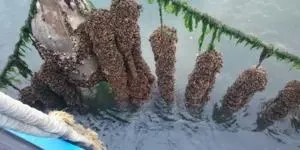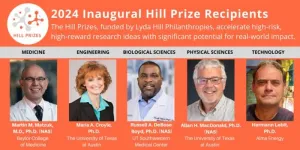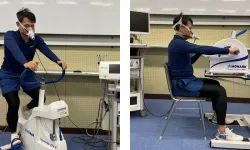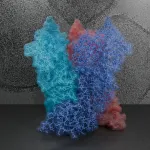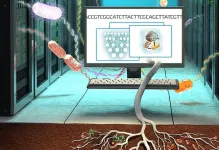(Press-News.org) The restoration of mussel beds in the Wadden Sea or the Delta is a lot more successful when young mussels are helped a little with low, protective fences on the bottom. That is shown by research conducted by marine biologist Jildou Schotanus at the Hogeschool Zeeland / University of Applied Sciences in Vlissingen and at the Royal Netherlands Institute for Sea Research in Yerseke. She defends her thesis Restoring mussel beds on highly dynamic mudflats at the University of Groningen on Monday February 5th.
Ecosystem engineers
Mussels are so-called ecosystem engineers. On large banks, mussels shape the environment to their liking. In this way, they facilitate other mussels to settle, meanwhile helping other animals and plants to find a safe place on the sea floor as well. Moreover, mussel beds retain silt and sand and dampen the energy of waves during storms. "For this reason, there are lots of initiatives to restore mussel beds," Schotanus knows. "But it is, usually, a daunting task!"
Rough conditions
One of the problems in restoring mussel beds is the type of mussel that is used, Schotanus explains. "In the past, adult mussels that were not used to dry conditions of intertidal mud flats were often used for this purpose. But if you suddenly try to get these mussels to settle on a mudflat that is exposed to air during low tide, where they also have to endure much more wave energy, they turn out to be unaccustomed to these conditions. Experiments we have done with very small mussels, the so-called mussel seed, show that these are still flexible enough to adapt to the rougher conditions on the tidal flats."
Headstart
In another experiment, Schotanus looked at how to give mussels the best headstart on the barren banks of the Oosterschelde (Eastern Scheldt). She experimented with breakwaters, with netting to keep hungry crabs away and with coir mats to help the shellfish adhere to the bottom. "All of these methods do work to some extent, but they are also very labor intensive," Schotanus says. “Relatively simple fencing that creates eddies in the currents, and can thus create lee for young mussels, seemed the most efficient in that sense."
Unaccustomed birds
One of the reasons for restoring mussel beds is to boost biodiversity. That is why Schotanus also used cameras to see how birds such as curlew and oystercatcher reacted to these strange structures on the tidal flats. “They appear to get used to them after a while," the researcher observed. "Gulls found the larger quantities of shellfish near the fences very quickly anyway. Oystercatchers needed some time and curlews also only discovered after some time, that there were also many small crabs near the fences, which is their favorite food."
Positive interactions
The most important lesson from her research, Schotanus thinks, is that in restoring mussel beds, you must take advantage of the positive interactions between the shellfish themselves. "Mussels simply find strength and safety in numbers. All our artificial tools have their drawbacks, so the simpler we can make it for the mussels, the better."
END
Fencing young mussels for ecosystem restoration
2024-02-05
ELSE PRESS RELEASES FROM THIS DATE:
Mild Covid-19 infections make insomnia more likely, especially in people with anxiety or depression
2024-02-05
Although most patients diagnosed with Covid-19 will quickly recover, some people experience symptoms that linger well after they start testing negative again — including insomnia. Scientists already knew that insomnia was common in patients who had to be hospitalized, but a team of scientists led by Dr Huong T. X. Hoang of Phenikaa University, Vietnam began to wonder if mild infections might also affect sleep quality.
“As a sleep researcher, I received many questions and complaints from relatives, friends, ...
Winners of the 2024 Hill Prizes announced
2024-02-05
Hill Prize in Medicine Awarded to Martin M. Matzuk, M.D., Ph.D. (NAS), Baylor College of Medicine
Hill Prize in Engineering Awarded to Maria A. Croyle, Ph.D., The University of Texas at Austin
Hill Prize in Biological Sciences Awarded to Russell A. DeBose-Boyd, Ph.D. (NAS), UT Southwestern Medical Center
Hill Prize in Physical Sciences Awarded to Allan H. MacDonald, Ph.D. (NAS), The University of Texas at Austin
Hill Prize in Technology Awarded to Hermann Lebit, Ph.D., Alma Energy
February 5, 2024 – Austin – TAMEST ...
Beyond the pedals: testing upper limb feasibility of cardiopulmonary exercise testing
2024-02-05
How can inclusivity be achieved in cardiopulmonary exercise tests for individuals facing lower limb injuries or disabilities that make it impossible to pedal a bicycle? Conventional exercise assessments rely primarily on lower limb exercise to determine maximal oxygen uptake – a cardiopulmonary function metric that indicates the maximum amount of oxygen that can be taken into the body in one minute. If lower limbs cannot be exercised, it necessitates an upper limb alternative. However, no clear upper limb ...
Making drug use less dangerous for users is the only way to tackle overdose epidemic
2024-02-05
With more than 100,000 drug overdose deaths in the United States in one year, communities need more than ‘just say no’ drug prevention education and abstinence-only addiction treatment to save lives, an expert has warned.
Statistics show that most people who complete conventional drug prevention education as youth eventually go on to use alcohol, nicotine, or illegal drugs.
Harm reduction expert Sheila P. Vakharia, PhD, MSW, explains: “The majority have experimented, others use socially, and some experience substance-related problems or addictions. And, regardless of their patterns of use, most have never been taught strategies for safer substance use, ...
Veterinary drug newly found in illicit opioid supply resistant to naloxone
2024-02-05
An article published in CMAJ (Canadian Medical Association Journal) describes five things clinicians and harm reduction workers should know about xylazine, a veterinary medication adulterating the illicit opioid supplyhttps://www.cmaj.ca/lookup/doi/10.1503/cmaj.231603.
There is no antidote to the effects of xylazine, and the authors explain that xylazine contamination should be suspected when naloxone appears not to work effectively in people with opioid toxicity.
Highlights:
Xylazine is not approved for use in humans and is increasingly found in illicit drug samples along with fentanyl. People using ...
Difficulty swallowing, allergies in children and young adults: is it eosinophilic esophagitis?
2024-02-05
Children and young adults with allergies or eczema who have difficulty swallowing may have eosinophilic esophagitis. A review published in CMAJ (Canadian Medical Association Journal) provides guidance on how to diagnose and manage this chronic inflammatory disease https://www.cmaj.ca/lookup/doi/10.1503/cmaj.230378.
In people with eosinophilic esophagitis, the esophageal lining is inflamed, which can cause injury and narrowing of the throat. Although it can affect anyone, the risk is higher in children aged 5–14 years ...
Down to the core of poxviruses
2024-02-05
A recent re-emergence and outbreak of Mpox brought poxviruses back as a public health threat, underlining an important knowledge gap at their core. Now, a team of researchers from the Institute of Science and Technology Austria (ISTA) lifted the mysteries of poxviral core architecture by combining various cryo-electron microscopy techniques with molecular modeling. The findings, published in Nature Structural & Molecular Biology, could facilitate future research on therapeutics targeting the poxvirus core.
Variola virus, the most notorious poxvirus and one of the deadliest viruses to have ...
New weight loss medication may help lower blood pressure in adults with obesity
2024-02-05
Research Highlights:
The weight loss medication tirzepatide significantly lowered the systolic blood pressure of nearly 500 adults who had obesity and took the medication for 36 weeks, or about eight months, in a subset of an international clinical trial.
Participants taking 5 mg of tirzepatide had an average systolic blood pressure reduction of 7.4 mm Hg; participants taking 10 mg had an average systolic blood pressure reduction of 10.6 mm Hg; and participants taking 15 mg had an average systolic blood pressure reduction of 8.0 mm Hg.
In this study, the blood-pressure lowering effects of tirzepatide were evident during both day and night ...
Study finds new treatment to reverse inflammation and arterial blockages in rheumatoid arthritis
2024-02-05
UNDER STRICT EMBARGO UNTIL 10AM (UK TIME) ON MONDAY 5 FEBRUARY 2024
Researchers from Queen Mary University of London have found that the molecule RvT4 enhances the body’s natural defences against atherosclerosis (hardening of the arteries) in patients with rheumatoid arthritis.
Studies in mice undertaken by researchers from Queen Mary University of London’s William Harvey Research Institute and Centre for Inflammation and Therapeutic Innovation, and funded by the European Research Council (ERC) and Barts Charity, shows that increasing levels of the RvT4 molecule in the body improves the ability of the body’s own defence ...
Improving climate predictions by unlocking the secrets of soil microbes
2024-02-05
Climate models are essential to predicting and addressing climate change, but can fail to adequately represent soil microbes, a critical player in ecosystem soil carbon sequestration that affects the global carbon cycle. A team of scientists led by the Department of Energy’s Lawrence Berkeley National Laboratory (Berkeley Lab) has developed a new model that incorporates genetic information from microbes. This new model enables the scientists to better understand how certain soil microbes efficiently store carbon supplied by plant ...


